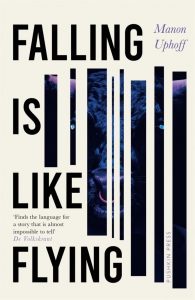Falling Is Like Flying
Manon Uphoff
(Pushkin Press, 2021); hbk £12.99
‘Reader,
I didn’t want to tell this story… But who can predict what will free itself from the darkness one day to chase us, like a frightened dog? ‘
Falling is Like Flying is Manon Uphoff’s autobiographical exploration of the traumatic sexual abuse experienced at the hands of her tyrannical father. With a courageous and extraordinary story to share, Uphoff returns to the dark labyrinth of her childhood to ‘catch sight of what I was there: the final doll in the matryoshka. The doll you can’t open.’ Despite her initial reticence, the recollections gather momentum as she relentlessly relives the trauma endured within a family that was both ordinary and deeply disturbed. The ‘frightened dog’ of Uphoff’s memory is unleashed, and bounds across the pages, often puppy like, sniffing out the rotten bones of buried depravation.
The depth of familial loyalty offers surprising insights, which Uphoff uses to explore conflict between the dangerous and complex psychological dynamics of family sexual violations and the tender and joyful moments that compound the child victim’s confusion. In a twisted world ‘as chilly as the tundra’ she acknowledges the child’s longing toward the only family she knows, at times claiming that: ‘All was well. Really and truly. Both inside and out’. Although siblings are fondly referred to by childhood nicknames – Toddiewoddie and Ninny – their father is sinisterly named ‘the Minotaur’. This potent mythical symbolism creates distance for the reader from the unthinkable yet we are still granted access to the abhorrence of her abuse. Uphoff’s adoration of her father is an uncomfortable truth. First describing him as a ‘Brilliant architect of our dread and excitement’, she also conveys the perturbing complexities of grooming when acknowledging that ‘we were accustomed early on to the eager goat’s-eye glance, and we did our best to deserve it.’
Translated from original Dutch, Uphoff’s intelligent writing remains evident. There are literary allusions throughout, influenced by the educated and aspirational Minotaur. By drawing on the dark imagery of the Anderson fairy tales read as a child, an elevated and mythical tone penetrates the narrative when abuse becomes too grim for candid description. Uphoff acknowledges living in a ‘world of magic and language in which no ‘I’ was yet necessary.’
Following her older sister’s death, however, Uphoff’s discovery of her own ‘I’ amidst the shaded terrors of memory becomes the triumph of Falling is Like Flying. Trauma compels the abused ‘I’ to find shape in the darkest corners of the Holbein child experience. Uphoff scavenges the splinters of a shattered identity, reassembling herself on the page while acknowledging her cultivation within the house of Holbein. Devastation and gratitude intertwine throughout.
Often child-like and colloquial but at times grand and intelligent, Falling is Like Flying is a captivating blend of densely expressive language and intimacy. By employing rhetorical questions, hushed exclamations, and revelations of her safety within abuse, the reader is also groomed: dazzled by flashes of cerebral language that soften the secrets so terrible. In this way, Uphoff creates a parallel experience for her readers by priming them as privileged confidants then whispering the grotesque details of her father’s depravity. As she hunts and gathers her lost fragments of self, the Minotaur begins to shrink and fade – ‘Such a little man. Such an ordinary man’ – and Uphoff emerges from the labyrinth. Falling is like Flying is testament to the necessity of exploring memory to reclaim, and celebrate, identity within and beyond abuse.
Victoria Lothian


Leave a Reply